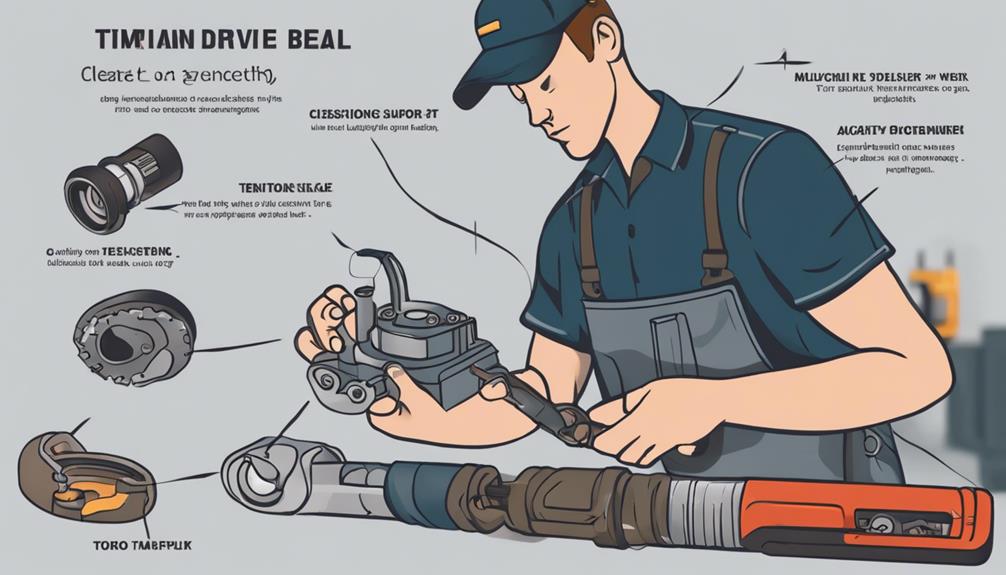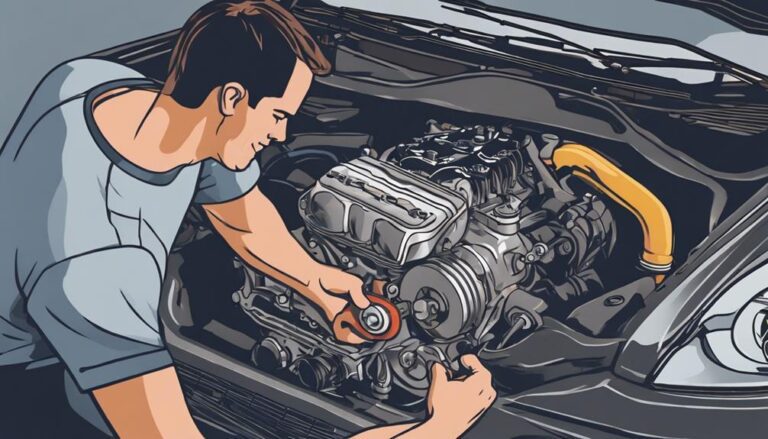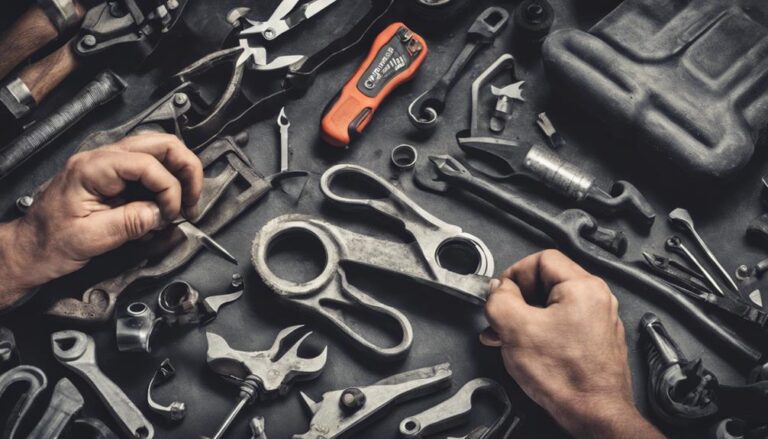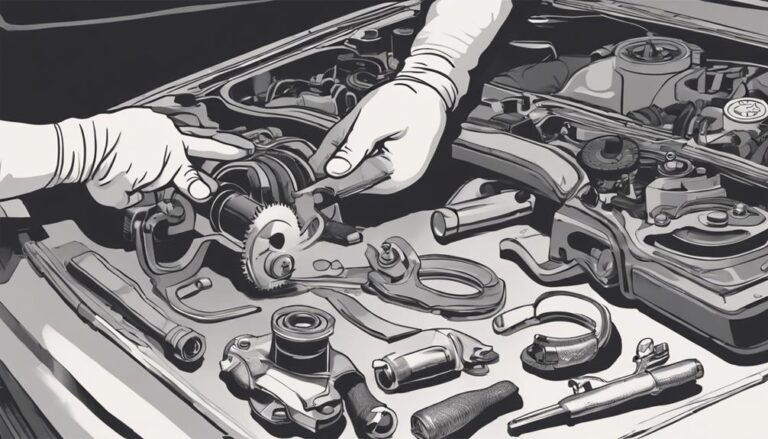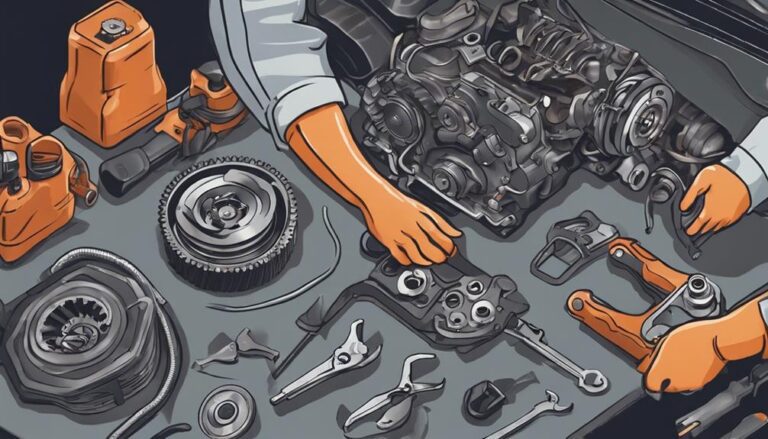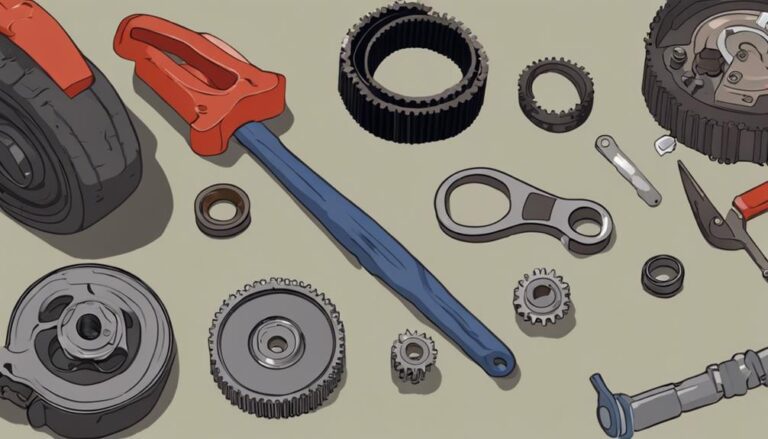Top 7 Drive Belt and Tensioner Maintenance Tips
You might think drive belt and tensioner maintenance is complicated, but with these straightforward tips, you can keep your vehicle running smoothly.
By understanding the importance of regular inspections, you can catch potential issues early on.
From signs of wear to proper tension adjustment techniques, each step plays a critical role in ensuring your vehicle's reliability.
Stay tuned to discover how these maintenance tips can save you time and money in the long run.
Key Takeaways
- Regular inspections prevent costly damages and breakdowns.
- Proper tension adjustment techniques ensure optimal functionality.
- Select high-quality belts compatible with vehicle specifications.
- Timely lubrication and cleaning extend drive belt and tensioner lifespan.
Importance of Regular Inspections

Regular inspections are paramount to ensuring peak performance and longevity of your drive belt and tensioner system. The inspection frequency should adhere to the manufacturer's recommendations, typically ranging from every 30,000 to 60,000 miles. By conducting these regular checks, you can identify potential issues early on, preventing costly damages and unexpected breakdowns.
The maintenance benefits of regular inspections are manifold. To begin with, they allow you to detect signs of wear and tear such as cracks, fraying, or glazing on the belt. Additionally, inspections help in evaluating the tensioner for proper alignment and tension, ensuring ideal functionality. Additionally, inspecting for any unusual noises or vibrations during operation can indicate underlying problems that need attention.
Signs of Belt or Tensioner Wear
Inspecting the drive belt and tensioner system for signs of wear is important in maintaining top performance and preventing potential failures. Symptoms of belt or tensioner wear may include visible cracks on the belt, squealing noises, vibrations, or the belt feeling loose to the touch. Ignoring these signs can lead to complete belt failure, causing the engine to overheat or other critical components to malfunction. When it comes to replacement options, it's essential to choose high-quality belts and tensioners to guarantee longevity and proper functioning of the system.
| Signs of Wear | Replacement Options |
|---|---|
| Visible cracks on the belt | Choose high-quality belts |
| Squealing noises | Opt for premium tensioners |
| Vibrations | Consider OEM replacements |
| Belt feels loose | Inspect pulleys for damage |
| Overheating engine | Replace both belt and tensioner |
Proper Tension Adjustment Techniques
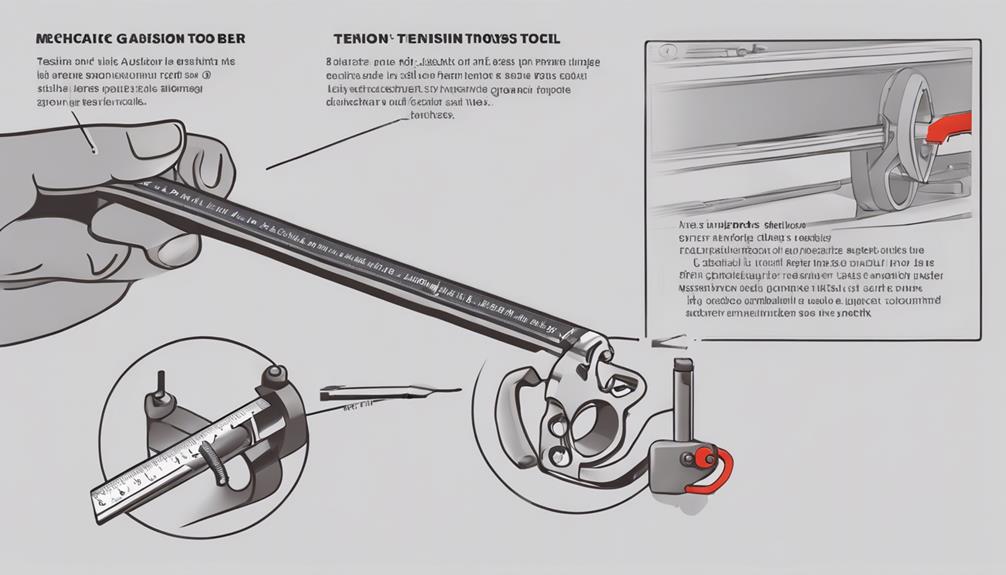
To guarantee prime performance and longevity of your drive belt system, accurate adjustment of tension is crucial for proper functionality and prevention of potential issues. Proper tensioning guarantees that the belt grips the pulleys correctly, reducing slip and wear.
Here are some maintenance techniques and best practices for tensioner adjustment:
- Utilize a Tension Gauge: Measure the tension accurately using a tension gauge for precise adjustments.
- Follow Manufacturer Guidelines: Refer to the manufacturer's specifications for the correct tension levels based on your vehicle's make and model.
- Check for Wear Regularly: Inspect the belt and tensioner for signs of wear or damage to address issues promptly.
- Adjust in Small Increments: Make adjustments gradually to prevent over-tensioning, which can lead to premature wear.
- Verify Alignment: Ensure the belt is properly aligned on all pulleys to prevent uneven wear and slippage.
Choosing the Right Belt Type
When selecting the appropriate belt type, consider factors like:
- Belt material
- Size
- Compatibility with your vehicle's specifications
The right belt should offer peak performance and durability under varying conditions. Make sure to choose a belt that meets the specific requirements of your vehicle's engine system to guarantee reliable operation.
Belt Material Selection
When selecting the right belt type for your vehicle, consider the specific material that will best suit your needs and guarantee peak performance. The material efficiency and durability of the belt play a vital role in ensuring top performance and longevity of your drive system. Here are some key points to keep in mind:
- Rubber Belts: Offer good flexibility and are suitable for most applications.
- Polyurethane Belts: Provide enhanced durability and resistance to oil and grease.
- Fiberglass-Reinforced Belts: Known for their high tensile strength and reliability.
- Kevlar Belts: Excellent for heavy-duty applications due to their superior strength.
- Composite Belts: Combine different materials to achieve a balance of strength and flexibility.
Size and Compatibility
Considering the material selection for your drive belt, the next important aspect to address is making sure the size and compatibility of the belt align perfectly with your vehicle's specifications for best performance. Proper belt size guarantees excellent power transfer and longevity. Additionally, verifying tensioner compatibility is vital as it impacts the belt's functionality and lifespan. When selecting a drive belt, follow manufacturer guidelines to guarantee the correct fit. Incorrect belt size or tensioner mismatch can lead to premature wear, slippage, or even belt failure. Regular maintenance checks and following installation techniques recommended by the manufacturer are essential to uphold performance and avoid costly repairs. Refer to the table below for guidance on belt size and compatibility:
| Belt Size | Tensioner Compatibility |
|---|---|
| Correct length | Compatible tensioner design |
| Proper width | Proper tension adjustment |
| Regular checks | Smooth operation |
| Replace as needed | Correct alignment |
| Follow manufacturer specs | Prevents premature wear |
Performance and Durability
To guarantee top performance and durability for your vehicle's drive belt, selecting the right belt type is essential. When choosing a drive belt, keep in mind that different belt materials and constructions can greatly impact your vehicle's efficiency and the lifespan of the belt. Here are some key considerations to help you improve efficiency and extend the lifespan of your drive belt:
- Opt for high-quality materials such as EPDM rubber for better durability.
- Choose a belt with the appropriate width and thickness for your vehicle's specifications.
- Consider getting a multi-ribbed belt for increased flexibility and reduced wear.
- Select a belt with a high tensile strength to withstand heavy loads.
- Look for belts with advanced features like anti-static properties for improved performance.
Ensuring Correct Alignment
Maintain the drive belt and tensioner's correct alignment to guarantee peak performance and longevity of your vehicle's engine components. Proper alignment ensures that the belt engages smoothly with all pulleys, preventing premature wear and potential damage to the engine. The tensioner plays a critical role in maintaining this alignment by adjusting the tension of the belt as needed to keep it in place.
To help you understand the significance of correct alignment further, let's look at the following table highlighting the key points:
| Alignment Importance | Tensioner Function |
|---|---|
| Ensures efficient power transfer | Adjusts belt tension |
| Prevents slippage | Maintains proper belt alignment |
| Reduces wear on components | Absorbs vibrations |
| Improves overall engine performance | Extends belt life |
Lubrication and Cleaning Tips
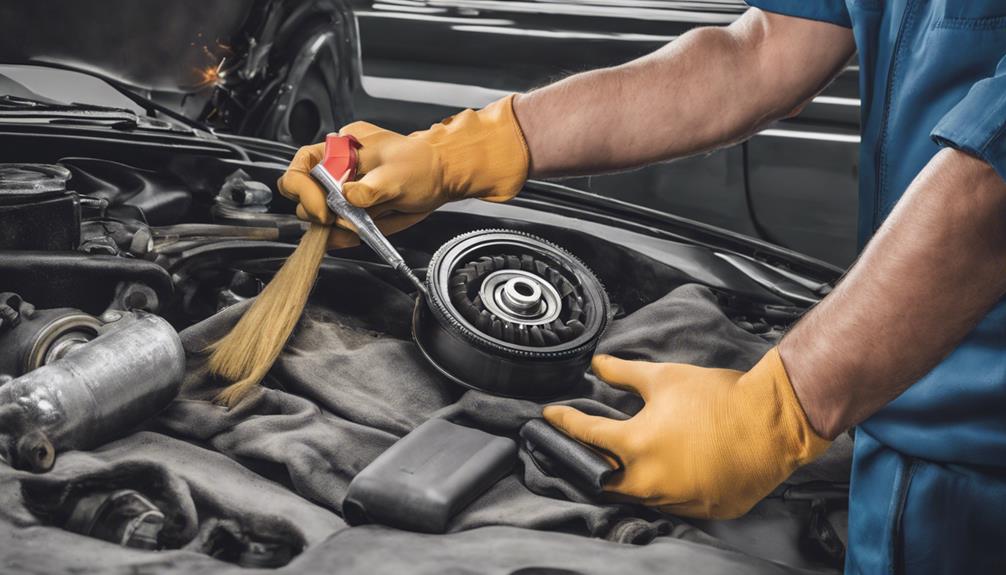
To maintain optimal performance, you should regularly lubricate the drive belt and tensioner components. Use compatible lubricants and follow proper cleaning techniques to guarantee longevity and efficiency.
Regular lubrication intervals and thorough cleaning practices are essential for the overall health of your drive belt system.
Lubrication Frequency
Guarantee proper lubrication of your drive belt and tensioner by following the recommended maintenance schedule provided by the manufacturer.
- Lubrication Intervals: Regularly check your manufacturer's guidelines for the recommended intervals between lubrication sessions.
- Benefits of Timely Lubrication: Secures smooth operation, reduces wear and tear, and extends the lifespan of the drive belt and tensioner components.
- Lubricant Selection: Always use the type of lubricant specified by the manufacturer for peak performance.
- Application Techniques: Apply the lubricant evenly across the drive belt and tensioner surfaces to prevent excess buildup or insufficient coverage.
- Monitoring: Keep track of the last lubrication session to secure you adhere to the recommended schedule and maintain peak performance.
Cleaning Techniques
Check that your lubrication process is complete and effective before moving on to the cleaning techniques for your drive belt and tensioner components. Proper cleaning methods are essential for belt longevity and tensioner efficiency. To maintain peak performance, regularly remove debris from the drive belt and tensioner.
Start by inspecting the belt for any signs of wear, cracks, or fraying. Use a soft brush or cloth to gently wipe off any visible dirt or grime. For more stubborn debris, a mild soap solution can be used, ensuring thorough rinsing and drying afterward. Avoid using harsh chemicals that could damage the belt material.
Compatible Lubricants
For important performance and longevity of your drive belt and tensioner components, selecting compatible lubricants is crucial to guarantee efficient operation and prevent premature wear.
When it comes to lubricant application, make sure you follow compatibility testing guidelines to safeguard your system.
Here are some key tips to keep in mind:
- Choose the Right Lubricant: Opt for a lubricant specifically designed for drive belt and tensioner use.
- Avoid Over-Lubrication: Applying too much lubricant can attract dirt and debris, leading to potential damage.
- Regular Inspection: Check for any signs of lubricant degradation or buildup to prevent issues.
- Follow Manufacturer Recommendations: Always adhere to the manufacturer's guidelines for lubricant selection and application.
- Monitor Performance: Keep track of your system's performance after lubricant application to ensure smooth operation.
Professional Maintenance Recommendations

When maintaining your drive belt and tensioner, it's essential to adhere to professional service schedules recommended by certified mechanics. These schedules dictate the timing for belt tensioning adjustments and overall maintenance checks. Keeping up with the maintenance schedule guarantees peak performance and longevity of your drive belt system.
Certified mechanics recommend regular inspections of the drive belt and tensioner assembly to identify signs of wear, misalignment, or damage. This proactive approach allows for timely replacements or adjustments, preventing potential breakdowns or costly repairs.
Professional maintenance also involves using high-quality replacement parts that meet or exceed the manufacturer's specifications. This guarantees compatibility and peak functioning of the drive belt and tensioner components.
Additionally, professional recommendations often include specific inspection points such as checking for proper belt tension, alignment, and pulley condition. Following these guidelines helps maintain the efficiency and reliability of your vehicle's drive belt system.
Frequently Asked Questions
Can Drive Belts and Tensioners Be Visually Inspected, or Is Specialized Equipment Required for a Thorough Inspection?
You can visually inspect drive belts and tensioners for wear, cracks, or misalignment without specialized equipment. This important maintenance tip helps detect issues early, ensuring best performance. Regular visual inspections are key to preventing costly repairs down the line.
How Often Should Drive Belts and Tensioners Be Replaced, Regardless of Their Condition?
You should replace drive belts and tensioners every 60,000 miles to maintain peak performance. While visual inspection suffices for wear assessment, periodic replacements guarantee reliability. Stay proactive in your maintenance routine for a smooth drive.
Are There Any Specific Environmental Factors That Can Accelerate Wear and Tear on Drive Belts and Tensioners?
Extreme temperatures and humidity, along with chemical exposure and contaminants, can accelerate wear on drive belts and tensioners. These environmental factors can lead to quicker deterioration and reduced lifespan of these components.
Is It Possible to Over-Tighten a Drive Belt, and What Are the Consequences of Doing So?
When you over-tighten a drive belt, you risk damaging components like the tensioner, pulleys, and the belt itself. Improper tensioning can lead to increased wear, noise, and decreased efficiency. Utilize proper inspection methods and tools to avoid these consequences.
Are There Any Aftermarket Products or Accessories That Can Prolong the Lifespan of Drive Belts and Tensioners?
To extend the lifespan of drive belts and tensioners, consider aftermarket products and accessories. Regular inspection, proper maintenance, and avoiding over-tightening are essential. Environmental factors and wear and tear influence replacement needs. Choose equipment wisely.
Conclusion
To sum up, maintaining your drive belt and tensioner is essential for preventing costly repairs and breakdowns.
By regularly inspecting for wear, adjusting tension properly, choosing the right belt type, ensuring correct alignment, lubricating and cleaning, and seeking professional maintenance when needed, you can keep your vehicle running smoothly.
Remember, neglecting these simple maintenance tasks could lead to catastrophic engine failure, so don't wait until it's too late to take action!

